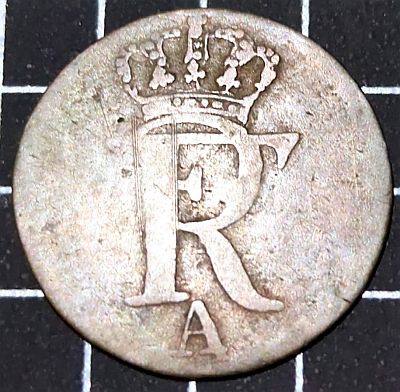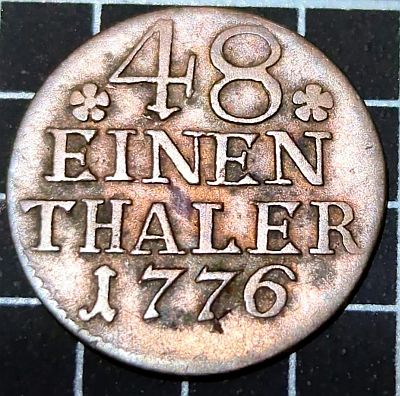An unusual denomination from a year I took a while to find.
Kingdom of Prussia

Map of Prussia & German States in the 19th century. From Wikipedia.
The early Prussians were a Baltic people comprised of multiple tribes. Their pagan faith is like that of Germanic and Greek paganism. Polish dukes and kings sent both missionaries and soldiers to Prussia as early as 997 to expand their domain. The Prussians responded by executing the missionaries and raiding Polish territory for loot and slaves.
In 1230 A.D., Knights of the Teutonic Order invaded the Prussians, overran most of the land within a decade. However, many Prussians simply hid their religion from the invaders, eventually staging uprisings throughout the rest of the 1200’s. By the end of the century, most Prussians had either moved to Lithuania where they could keep their paganism, or stayed in their lands, under the Catholic rule of the Teutonic Order.
In 1466, the Second Peace of Thorn ended the Thirteen Year’s War between Poland and the Teutonic Knights. The region was divided the region into Eastern Prussia (a fiefdom) and Western Prussia (a province to the Polish crown). In 1525, Albert, Grand Master of the German Teutonic Knights and nephew of the Polish King was named Duke of Eastern Prussia. However, he abandoned the Teutonic order’s Catholicism for Lutheran Protestantism as a state religion. Such divisions continued across Europe resulting in the Thirty Year’s War. Following the war, the newly dubbed Brandenburg-Prussia gained significant territorial expansion, eventually being freed from Polish control.
By 1701, Prussia had declared itself a Kingdom, and had a capital further west, in Berlin. To the west, several German States were becoming more powerful. Both Brandenburg and East Prussia fell under control of the Hohenzollern family, which would continue until WWI when West Prussia was dissolved. At the end of WWII, East Prussia was formally dissolved by the allies.
Obverse

The obverse of the coin features the crowned monogram of Frederick II – a joined R and F. The A underneath denotes the mint, Berlin.
Born in Berlin in 1712, Frederick, son of Frederick William I proved a courageous soldier and skilled strategist. Under his leadership, Prussia became one of the great states of Europe, with vastly expanded territories and impressive military strength.
The coin itself is Billon. Billon is an alloy of a precious metal, in this case 0.250 silver, with base metal (probably a bit of copper by the colour). It weighs 1.4g (0.05oz), so the silver content is around 0.35g (0.012oz) – worth around 35c US (I’d have been happy to pick it up for 35c, it did cost more but was not expensive). The coin is only 0.6mm (0.02in) thick and 18.5mm (0.73in) diameter.
Reverse

The reverse of the coin features the value and year. The value is written as “48 Einen Thaler” (1/48th of a Thaler).
Numista notes that some coins had stars rather than flowers around the 48. I’m not sure if that was only for 1773 or could be any coin in the set, which was minted each year from 1771 – 1781. Most years saw 20 – 60 million coins minted. There were only 52,000 issued in 1780. Neither Numista nor NCG list a mintage for 1781.
Under Prussia, Numista lists the denominations as:
“288 Pfennigs = 96 Gröschel
= 72 Kreuzer = 36 Mariengroschen
= 24 Groschen = 1 Thaler = ³⁄₁₇ Pistole”
So, I think that means:
- 1 Thaler = 24 Groschen
- 1 Groschen = 1 1/2 Mariengroschen or 3 Kreuzer or 4 Gröschel.
- 1 Gröschel = 3 Pfennigs
Some of these values seem to vary a little. For instance, this Frederick II Gröschel is listed as 1/90th of a Thaler, and this 3 Gröscher of Frederick William III is valued at 1/40th of a Thaler.
And because that isn’t complex enough, my coin isn’t actually a whole value of anything, but 1/48 Thaler. Which I think is 1/2 Groschen. Coins were also issued in other denominations too including:
- 1 Denier / Denar (worth 1 Pfennig)
- 1/4 Stuber (1/240 or 1/10 Groschen)
- and Poltura (2 Groschen, though listed as 1/48 Thaler)
as well as variants of the listed denominations such as Pfennige and Gröscher. It must have been an interesting time to be a maths student!
1776
I just thought I’d share a note about the year. So, one of the aims of my collection is to pick up at least one piece from every year going back as far as I can. I’ve been keeping an eye out for 1700s coins for a while. I quickly realised that 1776 was going to have unique challenges. The United States declared independence that year, which means there are a TON of commemorative coins and medallions bearing that date if you do a search on eBay for instance. Many were issued in 1976 for the Bicentennial, so adding -1976 can help, but even so you need to wade through a lot. 1788 had the same issue because of Australia’s European settlement that year. Numista lists 786 standard circulating coins from 1776. Just for the sake of filling a year, I don’t necessarily want the most expensive coin (if I spent $50 to get one new year, it would cost $500 to cover a decade). So, if you narrow that to “non-precious” (I.E. not gold or silver) coins, there were 256 coins issued. There should be a few different coins about, but while I can find coins from earlier in the 1700s, 1776 has been a harder year to find a coin than I anticipated. The keys with something like that is – there is no rush. Of the coins which exist today having survived that long, most will still exist in a decade. If you collect gold or silver coins, the price will probably vary as the price of those metals changes, but other than that, the cost shouldn’t be too different if you have to wait a few years to find the right one for your collection. Having said that, I’ll probably find three more next week for a couple of dollars each; that’s how it goes.
Do you collect by year? Which year has been hardest to find for you? Or what has been a “common” coin you have had a lot more trouble than expected finding?


Leave a Reply